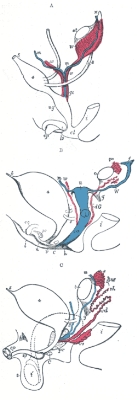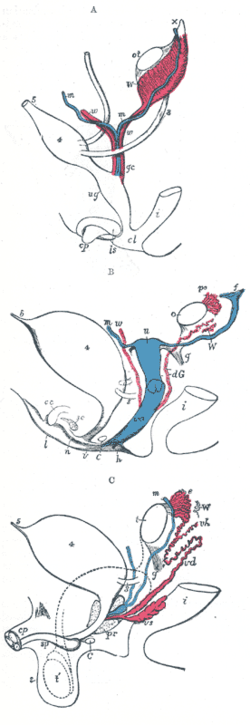
Müllerian duct
Encyclopedia
Müllerian ducts are paired ducts of the embryo
that run down the lateral sides of the urogenital ridge and terminate at the Müllerian eminence
in the primitive urogenital sinus. In the female, they will develop to form the Fallopian tube
s, uterus
, cervix
, and the upper two-third of the vagina
; in the male, they are lost. These ducts are made of tissue of mesoderm
al origin.
 The female reproductive system is composed of two embryological segments: the urogenital sinus and the Müllerian ducts. The two are conjoined at the Müllerian tubercle. Müllerian ducts are present on the embryo of both sexes. Only in females do they develop into reproductive organs. They degenerate in males, but the adjoining Wolffian duct
The female reproductive system is composed of two embryological segments: the urogenital sinus and the Müllerian ducts. The two are conjoined at the Müllerian tubercle. Müllerian ducts are present on the embryo of both sexes. Only in females do they develop into reproductive organs. They degenerate in males, but the adjoining Wolffian duct
s develop into male reproductive organs. The sex based differences in the contributions of the Müllerian ducts to reproductive organs is based on the presence, and degree of presence, of Müllerian Inhibiting factor.
(also known as "MIF" for "Müllerian-inhibiting factor", or "MIH" for "Müllerian-inhibiting hormone").
, a physiologist who described these ducts in his text "Bildungsgeschichte der Genitalien" in 1830.
Embryo
An embryo is a multicellular diploid eukaryote in its earliest stage of development, from the time of first cell division until birth, hatching, or germination...
that run down the lateral sides of the urogenital ridge and terminate at the Müllerian eminence
Müllerian eminence
The Müllerian eminence is an epithelial on the ventral part of the cloaca between the orifices of the Wolffian ducts. It appears during the development of the urinary and reproductive organs.-Function:The Müllerian ducts end here...
in the primitive urogenital sinus. In the female, they will develop to form the Fallopian tube
Fallopian tube
The Fallopian tubes, also known as oviducts, uterine tubes, and salpinges are two very fine tubes lined with ciliated epithelia, leading from the ovaries of female mammals into the uterus, via the utero-tubal junction...
s, uterus
Uterus
The uterus or womb is a major female hormone-responsive reproductive sex organ of most mammals including humans. One end, the cervix, opens into the vagina, while the other is connected to one or both fallopian tubes, depending on the species...
, cervix
Cervix
The cervix is the lower, narrow portion of the uterus where it joins with the top end of the vagina. It is cylindrical or conical in shape and protrudes through the upper anterior vaginal wall...
, and the upper two-third of the vagina
Vagina
The vagina is a fibromuscular tubular tract leading from the uterus to the exterior of the body in female placental mammals and marsupials, or to the cloaca in female birds, monotremes, and some reptiles. Female insects and other invertebrates also have a vagina, which is the terminal part of the...
; in the male, they are lost. These ducts are made of tissue of mesoderm
Mesoderm
In all bilaterian animals, the mesoderm is one of the three primary germ cell layers in the very early embryo. The other two layers are the ectoderm and endoderm , with the mesoderm as the middle layer between them.The mesoderm forms mesenchyme , mesothelium, non-epithelial blood corpuscles and...
al origin.
Development

Wolffian duct
The mesonephric duct is a paired organ found in mammals including humans during embryogenesis....
s develop into male reproductive organs. The sex based differences in the contributions of the Müllerian ducts to reproductive organs is based on the presence, and degree of presence, of Müllerian Inhibiting factor.
Regulation of development
The development of the Müllerian ducts is controlled by the presence or absence of "AMH", or Anti-Müllerian hormoneAnti-müllerian hormone
Anti-Müllerian hormone also known as AMH is a protein that, in humans, is encoded by the AMH gene. It inhibits the development of the Müllerian ducts in the male embryo. It has also been called Müllerian inhibiting factor , Müllerian-inhibiting hormone , and Müllerian-inhibiting substance...
(also known as "MIF" for "Müllerian-inhibiting factor", or "MIH" for "Müllerian-inhibiting hormone").
| Male embryogenesis | The testes produce AMH and as a result the development of the Müllerian ducts is inhibited. | Disturbances can lead to persistent Müllerian duct syndrome Persistent Mullerian duct syndrome Persistent Müllerian duct syndrome refers to the presence of a uterus and sometimes other Müllerian duct derivatives in a male animal... . |
appendix testis Appendix testis The appendix testis is a vestigial remnant of the Müllerian duct, present on the upper pole of the testis and attached to the tunica vaginalis. It is present about 90% of the time.-Clinical significance:... . >- | Female embryogenesis |
The absence of AMH results in the development of female reproductive organs, as noted above. | Disturbance in the development may result in uterine absence (Müllerian agenesis Mullerian agenesis Müllerian agenesis is a congenital malformation in women characterised by a failure of the müllerian ducts to develop, resulting in a missing uterus and fallopian tubes and variable malformations of the upper portion of the vagina. It is the second most common cause of primary amenorrhea after... ) or uterine malformation Uterine malformation A uterine malformation is a type of female genital malformation resulting from an abnormal development of the Müllerian duct during embryogenesis... s. |
The ducts develop into the upper vagina Vagina The vagina is a fibromuscular tubular tract leading from the uterus to the exterior of the body in female placental mammals and marsupials, or to the cloaca in female birds, monotremes, and some reptiles. Female insects and other invertebrates also have a vagina, which is the terminal part of the... , cervix Cervix The cervix is the lower, narrow portion of the uterus where it joins with the top end of the vagina. It is cylindrical or conical in shape and protrudes through the upper anterior vaginal wall... , uterus Uterus The uterus or womb is a major female hormone-responsive reproductive sex organ of most mammals including humans. One end, the cervix, opens into the vagina, while the other is connected to one or both fallopian tubes, depending on the species... and oviducts. |
Eponym
They are named after Johannes Peter MüllerJohannes Peter Müller
Johannes Peter Müller , was a German physiologist, comparative anatomist, and ichthyologist not only known for his discoveries but also for his ability to synthesize knowledge.-Early years and education:...
, a physiologist who described these ducts in his text "Bildungsgeschichte der Genitalien" in 1830.
See also
- DefeminizationDefeminizationDefeminization is a term in developmental biology, especially zoology, referring to an aspect of the process of sexual differentiation by which a potential female-specific structure, function, or behavior is prevented from developing by one of the processes of male development...
- prostatic utricleProstatic utricleThe prostatic utricle is a small indentation located in the prostatic urethra, at the apex of the urethral crest, on the seminal colliculus , laterally flanked by openings of the ejaculatory ducts...
- List of homologues of the human reproductive system
- Sexual differentiationSexual differentiationSexual differentiation is the process of development of the differences between males and females from an undifferentiated zygote...
External links
- How the Body Works / Sex Development / Sexual Differentiation / Duct Differentiation - The Hospital for Sick Children (GTA - Toronto, Ontario, Canada)

